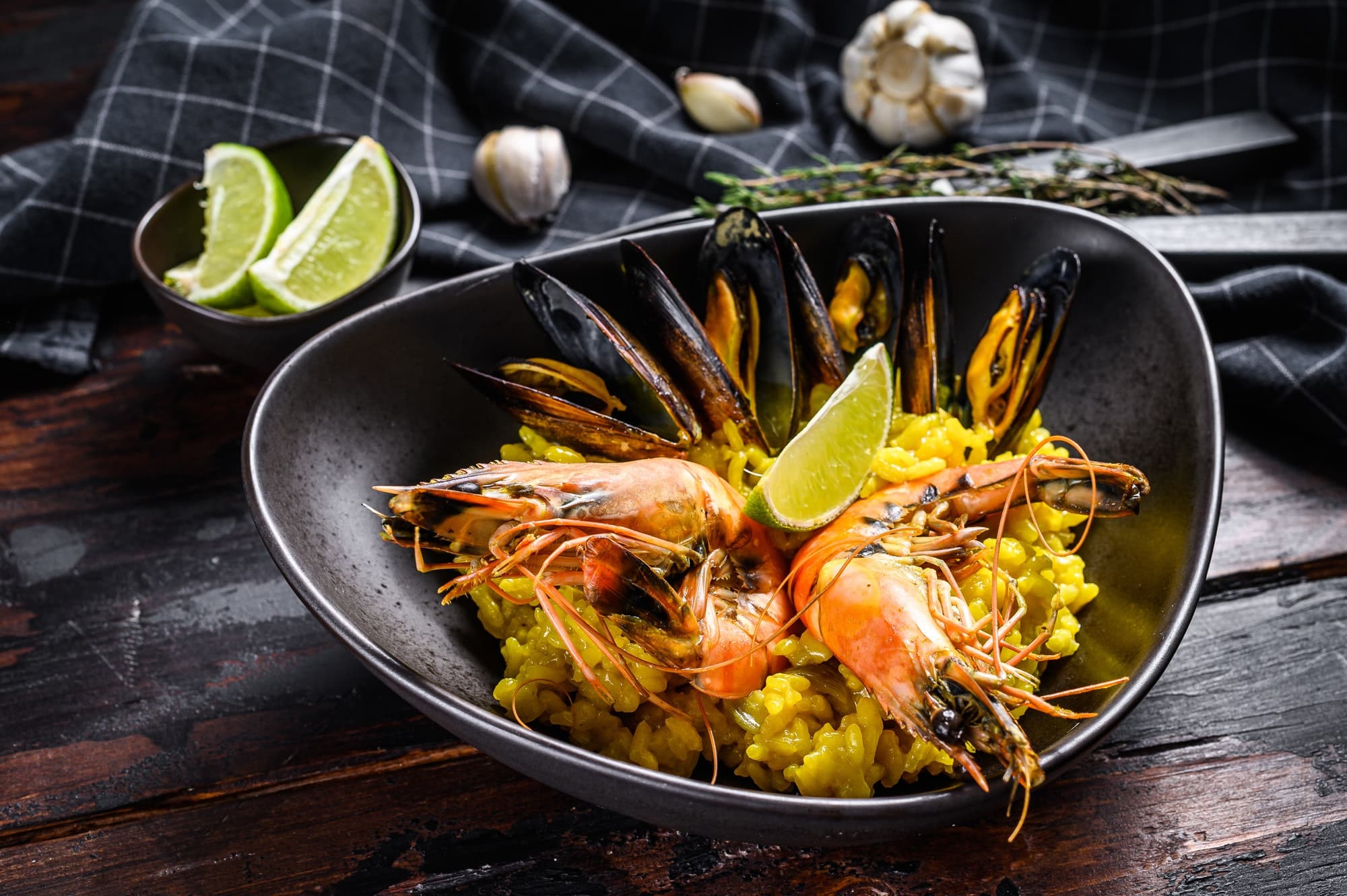What’s the Secret to a Flavorful Seafood Paella with Saffron and Fresh Shellfish?

Paella, the famed Spanish dish, is a riot of flavors and colors that is sure to delight your palate. Combining perfectly cooked rice with a medley of seafood, chicken, and a variety of other ingredients, paella is a testament to the richness of Spanish cuisine. But how do you create the perfect seafood paella with saffron and fresh shellfish, you ask? We’re going to break it down into manageable steps, from selecting the right rice to the finishing touches that make a paella truly shine.
The Right Rice and Pan: Foundation of a Perfect Paella
The first two elements to consider in making an exquisite paella are the rice and the pan. The type of rice you use in your paella can significantly influence the texture and flavor of the dish. Paella rice is a short-grain variety that can absorb a great deal of liquid – and, more importantly, flavor – without becoming mushy. This is key to achieving the perfect consistency for your paella. In the absence of Spanish rice, Italian arborio rice makes a decent substitute.
Sujet a lire : How to Craft a Delicate Apple Tarte Tatin with a Caramelized Crust?
When it comes to the pan, traditionalists will insist on a proper paella pan, which is wide, shallow, and made of thin metal. However, any large, shallow pan with a heavy bottom will do. The wide surface area is crucial for achieving socarrat, the thin layer of toasted rice at the bottom of the pan that is the highlight of a good paella.
Savoring the Saffron: Adding the Golden Touch
Saffron, the world’s most expensive spice, is a key component in a traditional paella recipe. Its unique flavor and golden color lend a distinctive touch to the dish. To make the most of saffron, it should be added early in the cooking process. Warm it gently in a little stock or water before adding it to the pan, allowing its flavor to permeate the broth. Remember, a little saffron goes a long way, and its flavor can easily overpower the other ingredients if used in excess.
Cela peut vous intéresser : What’s the Secret to a Perfectly Layered Mille-Feuille with Vanilla Pastry Cream?
Mastering the Art of Seafood Selection
Nothing elevates a seafood paella like the use of fresh, high-quality seafood. This recipe calls for a mix of shellfish, typically shrimp and mussels, and occasionally, clams. When selecting shrimp, look for ones that are firm and have a mild scent. As for mussels, they should be tightly closed or close when tapped. If they don’t close, this indicates that they are no longer fresh.
Layering Flavors: Building the Paella
Your paella begins with a sofrito, a flavorful combination of garlic, onions, and tomatoes cooked in olive oil. This mixture forms the base of the paella, providing a deep, savory foundation to build upon. From here, the chicken and seafood are added to the pan and browned, adding another layer of flavor.
Next, the rice is added to the pan and cooked briefly to absorb the flavors from the sofrito, chicken, and seafood. The saffron-infused stock is then poured in, and the rice is left to simmer, soaking up the flavorful broth.
Timing Is Everything: The Cooking Process
Cooking a perfect paella is as much about technique as it is about ingredients. After the stock is added, the rice should simmer over medium heat without stirring. This allows the rice to absorb the broth evenly and helps develop the socarrat. After about 20 minutes, when most of the broth has been absorbed, the heat should be increased briefly to create the crispy socarrat at the bottom of the pan.
Finishing Touches: Serving the Paella
Once the paella is cooked, it’s important to let it rest for a few minutes before serving. This allows the flavors to meld together and the residual heat to finish cooking the rice. The paella is then ready to be served directly from the pan, with lemon wedges on the side to enhance the flavors.
In summary, creating a flavorful seafood paella with saffron and fresh shellfish is a matter of choosing the right ingredients, applying proper technique, and most importantly, lavishing the dish with time and attention.
The Sensational Spanish Ingredients: An Alluring Array of Flavors
Creating an authentic and flavorful seafood paella hinges on the careful blend of characteristic Spanish ingredients. At the start, you will need quality olive oil. A cornerstone of Spanish cuisine, olive oil is used to cook the sofrito and to brown the seafood and chicken, infusing the dish with its rich, fruity flavor.
Your arsenal of spices should include smoked paprika, another quintessentially Spanish ingredient. Adding a dash of smoked paprika imparts a warm, smoky flavor and a vibrant hue to your paella. Likewise, a splash of white wine can enhance the overall flavor profile of the dish, adding a hint of acidity and complexity.
It’s worth noting that the true star of any paella recipe is the saffron. Although it’s often reserved for special dishes due to its high cost, saffron’s unique flavor and ability to tint the dish with a golden color make it invaluable when cooking paella.
As for the seafood, a combination of shrimp and mussels works wonderfully. The freshness of the seafood, combined with the Spanish rice – also known as bomba rice – contributes greatly to the final taste. Bomba rice is a short grain variety native to Spain that excels at absorbing flavors while retaining its shape and texture. If you have difficulty sourcing it, a good substitute would be an Italian short grain rice such as arborio.
Lastly, you’ll need a flavorful chicken broth to serve as the cooking liquid. The grain rice will soak up this broth, transforming from plain, starchy granules into rich, flavorful morsels.
An Ode to the Paella Pan: A Tribute to Tradition
When cooking a traditional dish like paella, using the right equipment is as essential as using the right ingredients. A proper paella pan, a thin, wide, shallow pan made from metal, is a key player in achieving the perfect paella. If you cannot find one, a large, shallow pan with a heavy bottom will work just as well.
The importance of the paella pan lies in its design. Its wide and shallow structure allows the rice to spread out and cook evenly. This is crucial in achieving the socarrat, the crispy, slightly caramelized layer of rice at the bottom of the pan, which is a hallmark of a well-made paella.
Besides, the pan’s thin metal construction ensures rapid heat distribution, allowing the cook to control the cooking process accurately. This precise control over the heat is essential to avoid overcooking the delicate seafood.
Remember, once the heat is increased towards the end of the cooking process, you only have a few minutes – typically around 5 minutes – to achieve the socarrat before the paella risks becoming burned. This is where the thinness of the paella pan proves to be most beneficial as it allows the heat to dissipate quickly once removed from the source, halting the cooking process and preventing the rice from overcooking.
Wrapping It Up: The Secret to a Flavorful Seafood Paella
Creating a flavorful seafood paella with saffron and fresh shellfish is an art that involves a delicate balance of ingredients, timing, and technique. From the choice of Spanish short grain rice to the golden threads of saffron, the freshness of the seafood to the thin, wide paella pan, every element plays a vital role in the making of this iconic Spanish dish.
The cooking process demands patience, from gently sautéing the sofrito in olive oil to allowing the rice to simmer undisturbed, soaking up the flavors from the chicken broth and other ingredients. Cooking the paella on medium heat, then increasing it briefly to create the socarrat, and finally letting it rest before serving, are all crucial steps that cannot be rushed.
In essence, the secret to a perfect seafood paella lies not only in its ingredients but also in the love, patience, and respect for tradition with which it is made. So, don your apron, gather your ingredients, and embark on the rewarding journey of making your own flavorful seafood paella. It will be worth every minute of effort and every grain of rice.
